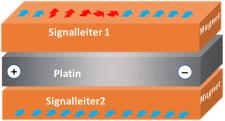New study shows how heat can be used in computing

Electric current flow heats up electronic device. The generated heat is dissipated and energy is lost. "For decades, people have been looking for ways to re-use this lost energy in electronics," explains Dr Jamal Berakdar, a professor of physics at MLU. This is extremely challenging, he says, due to the difficulty in directing and controlling accurately heat signals. However, both are necessary if heat signals are to be used to reliably process data.
Berakdar carried out extensive calculations together with two colleagues from Central South University in China. The idea: instead of conventional electronic circuits, non-conductive magnetic strips are used in conjunction with normal metal spacers. "This unusual combination makes it possible to conduct and amplify heat signals in a controlled manner in order to power logical computing operations and heat diodes," explains Berakdar.
One disadvantage of the new method, however, is its speed. "This method does not produce the kind of computing speeds we see in modern smartphones," says Berakdar. That is why the new method is currently probably less relevant for use in everyday electronics and is better suited for next generation computers which will be used to perform energy-saving calculations. "Our technology can contribute to saving energy in information technology by making good use of surplus heat," Berakdar concludes.
The study was funded by the German Research Foundation (DFG), the National Natural Science Foundation of China, the Natural Science Foundation of Hunan Province and as part of the Central South University Innovation-Driven Research Program.
Study: Wang X., Guo G., Berakdar J. PT-Symmetry Enabled Spintronic Thermal Diodes and Logic Gates. Advanced Electronic Materials (2023). doi: 10.1002/aelm.202300325

